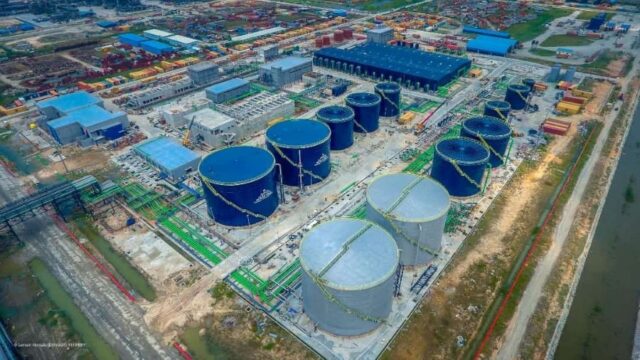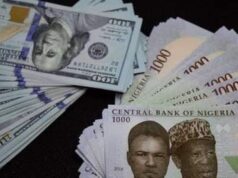
THUR, JULY 06 2023-theGBJournal | The naira remains on the back foot against the US dollar as FX demand continues to outstrip supply.
The demand for the greenback remains high as market players continue to source for FX to fulfil and clear their outstanding obligations, just as the CBN’s FX interventions remain frail.
At the same time, offshore players remain on the sidelines amidst existing challenges, including FX illiquidity, lack of flexibility in the exchange rate framework, high global interest rates, and an overvalued local currency.
However, the CBN abolished its multiple FX windows, collapsing all its various rates into the Investors and Exporters Window (IEW) on 14 June.
In line with the preceding, the naira depreciated significantly by 39.5% year-to-date (as of 27 June) to N763.00/USD at the Investors and Exporters Window (IEW).
Simultaneously, the exchange rate pressures also manifested in the gross FX reserves depletion of 7.7% to USD34.22 billion year-to-date, as FX inflows remain limited while the CBN used the reserves to finance external obligations and support the FX market.
On the FX inflows, crude oil exports remain low, capital importation continues to dry up, and the country cannot access the Eurobond market, given unfavourable external conditions.
Elsewhere, In May, the total inflows into the Investors & Exporters Window (IEW) increased by 46.8% m/m to USD1.14 billion (April: USD775.70 million).
Although foreign inflows settled higher to USD207.10 million (April: USD96.20 million), they remain underwhelming relative to pre-pandemic levels (2019FY monthly average: USD1.56 billion), primarily because of the existing FX constraints and limited macro reforms.
Simultaneously, inflows from local sources increased by 37.1% m/m to USD931.50 million, primarily driven by higher inflows from Exporters (+42.7% m/m to USD437.80 million | 47.0% of local inflows) and Non-bank corporates (+30.3% m/m to USD440.00 million | 47.2% of local inflows)
The Impact of Dangote Refinery on FX Savings May Be Limited
On the expected impact of Dangote Refinery on the local currency, we think the FX savings will be limited in the short term.
On the one hand, we expect the significant savings to be in terms of freight cost, which we estimate at N20.07/litre (or 6.0% of the expected open market price), amounting to N659.30 billion (or USD1.43 billion) per annum based on 90 million litres consumption per day.
On the other hand, our analysis of CBN’s data during pre-COVID levels shows that Nigeria needs to ramp up crude oil exports to a range of 1.50mb/d – 1.70mb/d to maintain a decent level of FX reserves which can be used to support the local currency.
The preceding means that crude oil production (excluding condensates) will need to increase from the current 1.27mb/d to between 1.95mb/d – 2.15mb/d after adding the approximate 450kb/d under the Direct Sales Direct Purchases (DSDP) contract.
Consequently, we think the central turning point is if Nigeria produces enough crude oil equal to or higher than its OPEC production quota, of which the extra barrels can be exported for hard currencies.
Thus, given that our crude oil production (excluding condensates) expectation for 2023FY (1.37mb/d) is 21.3% below Nigeria’s current OPEC production quota (1.74mb/d) and taking into account the FX savings from logistics costs, we do not see a meaningful impact of the Dangote Refinery on FX savings or the naira in the near term.
CBN Abolishes its Multiple FX Windows, Collapsing them into the IEW As noted earlier, the CBN abolished its multiple FX windows, collapsing all its various rates into the Investors and Exporters Window (IEW) on 14 June.
Accordingly, the CBN re-introduced the “willing buyer, willing seller” model at the IEW, with the operations guided by the extant circular on establishing the window, dated 21 April 2017.
In line with this, we now expect a more market determined exchange rate, boosting stakeholders’ confidence and increasing FX inflows, as there will no longer be an incentive to channel FX through the unofficial markets to take advantage of arbitrage opportunities.
Besides, we expect the associated FX unification to support government revenue in the medium term, given that dollar-based income will now be converted using a higher exchange rate.
The domestic capital market is also expected to benefit from the FX liberalisation as naira asset valuation becomes attractive for foreign investors, increasing foreign portfolio inflows.
FX inflows from diaspora remittances and exports are also likely to increase as there will no longer be a preference for diverting FX flows to the unofficial FX market, consequently boosting FX liquidity.
Conversely, we expect foreign debt service cost to increase in naira terms, just as the external debt is likely to induce a higher public debt profile relative to pre-FX liberalisation. On our estimates, the FX liberalisation would lead to an N11.32 trillion increase in total public debt even without contracting new debt in the current year.
Thus, for 2023FY, public debt is likely to hit NGN89.11 trillion (or 42.4% of GDP) assuming (i) N720.00/USD exchange rate on external debt outstanding, (ii) the government borrows NGN1.76 trillion it expects from multilateral/bilateral sources, and (iii) CBN’s Ways & Means is eventually added to the debt stock.
Elsewhere, we expect import costs to rise, negatively impacting domestic prices. Consequently, increased cost pressures will likely limit near-term growth as consumption expenditure and business investments are negatively impacted.
That said, we note that the external position (measured by the CA balance) positively correlates with the FX reserves. Thus, given our expectations of a slightly favourable CA balance relative to 2022FY, we expect inflows to the gross FX reserves to remain tempered relative to pre-pandemic levels.
The preceding is likely to impede the CBN’s ability to sufficiently increase its FX sales to the IEW, more so that the country is not expected to access the Eurobond market in the current year as global conditions remain unfavourable.
Nonetheless, we expect foreign investors’ sentiments to improve, albeit below pre-pandemic levels, in line with the liberalisation of the FX market.
However, they may not return in their droves if they do not see convincing actions from the CBN on clearing the FX backlog and supporting the market to reduce volatility in the short term.
Covering All Bases
On the CBN’s liquidity position, we estimate average monthly oil inflows of USD775.01 million over H2-23. The preceding is based on our crude oil average price estimate (USD80.66/bbl.) and expectations on average crude oil exports (0.90mb/d), after accounting for production (1.44mb/d) estimates, excluding condensates.
Furthermore, we project average monthly non-oil inflows to increase by 27.9% y/y, given the favourable base effects from the prior year and the impact of FX liberalisation on non-oil inflows, to USD1.89 billion in H2-23.
Thus, we expect the average monthly inflows into the CBN’s coffers to settle at USD2.66 billion in H2-23 (H2-22: USD2.25 billion).
On our expectations for the CBN’s FX outflows, we assume that the CBN’s halt of FX sales to the BDCs will remain intact. At the same time, we expect the CBN’s FX allocation to commercial banks to increase slightly for onward sales to the retail segment as FX demand pressures remain intact.
At the same time, we assume that CBN’s inflows to the IEW will increase compared to 2022FY levels, given our view that the CBN may increase its FX supply in the window to support the market in the early days of the FX liberalisation and reduce FX volatility.
Overall, we expect the CBN’s average monthly cash outflow to increase by 8.9% y/y to USD2.91 billion in H2-23 (H2-22: USD2.68 billion).
On balance, our estimated monthly average net cash flow translates to a reserve depletion of USD1.50 billion over H2-23 (vs depletion of USD2.56 billion in H2-22).
Consequently, we expect the reserves to settle at USD33.01 billion at the end of 2023, translating to import cover (goods) of about five months.
That said, it is essential to reiterate the CBN’s actions of abolishing its multiple FX windows, which, combined with the PMS subsidy removal, are favourable for the economy over the medium term.
We view these two reforms as vital and low hanging fruits that should have been implemented years ago for the economy not to be in the present fiscal and monetary mess.
However, we highlight that there are still some restrictions on eligible transactions in the IEW. One such is that the CBN maintained that the 43 items banned from accessing FX at the IEW remain intact, potentially undermining the path towards exchange rate unification.
Nonetheless, given the commitment of the current CBN’s leadership to improve its reputation and focus squarely on monetary policy, we will not be surprised to see positive changes in this regard over the medium term.
Overall, while the CBN’s FX liberalisation is positive in boosting foreign investor’s confidence, we think they may adopt a wait-and-see approach, for now, looking for signals on the CBN’s plans to start clearing the FX backlogs and boosting FX supply to support the market in the near term.
Besides, we suspect that due to the previous lessons learnt from the damaging currency controls of the prior administration, investors will be on the lookout for signs that there are no counter policies to prevent them from leaving at any point in the near term before returning to the market in their droves. Analysis is provided by Cordros Research.
Twitter-@theGBJournal|Facebook-the Government and Business Journal|email:gbj@govbusinessjournal.com| govandbusinessj@gmail.com









